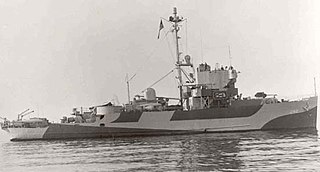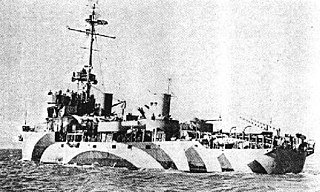
USS Inaugural (AM-242) was an Admirable-class fleet minesweeper. The Admirable class was the largest and one of the most successful classes of U.S. minesweepers ordered during World War II. Inaugural was launched on 1 October 1944 and commissioned less than three months later. After seeing combat in the Pacific Theater, she was decommissioned in 1946 and spent two decades in mothballs.

USS Lamberton (DD-119)/(DMS-2) was a Wickes-class destroyer in the United States Navy in commission from 1918 to 1922 and from 1930 to 1946. She saw service during World War II. She was the only ship named for Benjamin P. Lamberton, a rear admiral who served with Admiral Dewey in the Battle of Manila Bay in 1898 during the Spanish–American War.

USS Terror (CM-5) was a fleet minelayer of the United States Navy, the only minelayer of the fleet built specifically for and retained for minelaying during World War II.

USS Pledge (AM-277) was an Admirable-class minesweeper built for the U.S. Navy during World War II. She was built to clear minefields in offshore waters, and served the Navy in the Atlantic Ocean and then was transferred to the North Pacific Ocean. She survived the world war and was awarded one battle star, but, during the Korean War, she struck a mine and was sunk. She received the Presidential Unit Citation for her Korean service.
USS Skylark (AM-63) was an Auk-class minesweeper built for the United States Navy during World War II. She earned three battle stars during World War II. Skylark was mined and sunk off Okinawa in April 1945. She was struck from the Naval Vessel Register the same day.

USS Starling (AM-64) was an Auk-class minesweeper acquired by the United States Navy for the dangerous task of removing mines from minefields laid in the water to prevent ships from passing.

The second USS Ardent (AM-340) was a Auk-class minesweeper in the United States Navy.

USS Chief (AM-315) was an Auk-class minesweeper acquired by the United States Navy for the dangerous task of removing mines from minefields laid in the water to prevent ships from passing, and named after the word "chief," the head or leader of a group.
USS Token (AM-126) was an Auk-class minesweeper acquired by the United States Navy for the dangerous task of removing mines from minefields laid in the water to prevent ships from passing.
USS Tumult (AM-127) was an Auk-class minesweeper acquired by the United States Navy for the dangerous task of removing mines from minefields laid in the water to prevent ships from passing.
USS PCS-1465 was a PCS-1376-class minesweeper built for the United States Navy during World War II. Late in the war she was renamed and reclassified Minah (AMc-204), and in the 1950s reclassified first as AMCU-14 and later as MHC-14. Named for the myna under a variant spelling, she was the only U.S. Navy ship of that name.
USS Superior (AM-311) was a steel-hulled Admirable-class minesweeper built for the U.S. Navy in 1944. Superior participated in the final struggle in the Pacific Ocean against the Empire of Japan during the end of World War II and remained behind, after the war ended, to clear minefields laid during the war.
USS Staunch (AM-307) was a steel-hulled Admirable-class minesweeper built for the U.S. Navy during World War II. Her crew was quickly trained in the art of minesweeping and then sent to the Pacific Ocean to clear dangerous mine fields so that Allied troops could land on Japanese-held beaches. Because of her courageous work under fire, she was awarded four battle stars.
USS Spectacle (AM-305) was a steel-hulled Admirable class minesweeper built for the U.S. Navy during World War II. A trained crew boarded the new vessel, practiced with her minesweeping gear, and then proceeded to the Pacific Ocean to clear mines from Japanese beaches so that Allied forces could invade. While performing this dangerous task of mine clearance, a Japanese plane strafed her, and another deliberately crashed into her. When she returned to the United States, her battle damage was so severe that the U.S. Navy decided to scrap, rather than to repair, her. She was awarded two battle stars.
USS Scurry (AM-304) was a steel-hulled Admirable-class minesweeper constructed for the U.S. Navy during World War II. She was crewed by sailors who were trained in minesweeping, and quickly sent to the Pacific Ocean to clear minefields so that Allied forces could invade Japanese-held beaches. For this dangerous work, often under enemy fire, she was awarded four battle stars.
USS Compel (AM-162) was an Admirable-class minesweeper built for the U.S. Navy during World War II. She was built to clear minefields in offshore waters, and served the Navy in the Pacific Ocean. Compel was awarded one battle star for World War II service.

USS Quest (AM-281) was an Admirable-class minesweeper built for the United States Navy during World War II. She was decommissioned in 1947 after wartime service and transferred to the Philippine Navy in 1948 where she served as presidential yacht RPS Pag-asa (APO-21). In 1955, she was renamed Santa Maria and, later, Mount Samat (TK-21), serving as a patrol corvette of the Miguel Malvar class. She was decommissioned from the Philippine Navy in 1970; beyond that, her fate is not reported in secondary sources.
USS Skirmish (AM-303) was an Admirable-class minesweeper built for the United States Navy during World War II. She received four battle stars during World War II. She was decommissioned in December 1945 and placed in reserve. In February 1955, while still in reserve, her hull number was changed from AM-303 to MSF-303, but she was not reactivated. She was transferred to the Dominican Republic in January 1965 and renamed Separación (BM455). She was employed as a patrol vessel in Dominican Navy service and renamed Prestol Botello in 1976. Her pennant number was changed from BM454 to C454 during a 1995 refit. As of 2007, Prestol Botello remained in active service for the Dominican Navy.
USS Prestige (AMc-97) was an Accentor-class coastal minesweeper acquired by the U.S. Navy for the dangerous task of removing mines from minefields laid in the water to prevent ships from passing.

USS Loyalty (AMc-88) was an Accentor-class coastal minesweeper acquired by the U.S. Navy for the dangerous task of removing mines from minefields laid in the water to prevent ships from passing.









